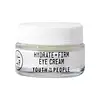What's inside
What's inside
 Key Ingredients
Key Ingredients

 Benefits
Benefits

 Concerns
Concerns

 Ingredients Side-by-side
Ingredients Side-by-side

Water
Skin ConditioningGlycerin
HumectantBrassica Oleracea Acephala Leaf Extract
HumectantSpinacia Oleracea Leaf Extract
Skin ConditioningCamellia Sinensis Leaf Extract
AntimicrobialChamomilla Recutita Flower Extract
MaskingMedicago Sativa Extract
TonicAloe Barbadensis Leaf Extract
EmollientSpirulina Platensis Extract
Skin ProtectingPalmitoyl Tripeptide-5
Skin ConditioningPalmitoyl Dipeptide-5 Diaminobutyroyl Hydroxythreonine
Skin ConditioningTetradecyl Aminobutyroylvalylaminobutyric Urea Trifluoroacetate
Skin ConditioningSodium Hyaluronate Crosspolymer
HumectantHelianthus Annuus Seed Oil
EmollientStearic Acid
CleansingGlyceryl Stearate
EmollientCetyl Alcohol
EmollientLecithin
EmollientAscorbic Acid
AntioxidantPanthenol
Skin ConditioningSodium Hyaluronate
HumectantTocopheryl Acetate
AntioxidantParfum
MaskingHydroxyethylcellulose
Emulsion StabilisingPentylene Glycol
Skin ConditioningEthylhexylglycerin
Skin ConditioningMagnesium Chloride
Phenoxyethanol
PreservativePotassium Sorbate
PreservativeWater, Glycerin, Brassica Oleracea Acephala Leaf Extract, Spinacia Oleracea Leaf Extract, Camellia Sinensis Leaf Extract, Chamomilla Recutita Flower Extract, Medicago Sativa Extract, Aloe Barbadensis Leaf Extract, Spirulina Platensis Extract, Palmitoyl Tripeptide-5, Palmitoyl Dipeptide-5 Diaminobutyroyl Hydroxythreonine, Tetradecyl Aminobutyroylvalylaminobutyric Urea Trifluoroacetate, Sodium Hyaluronate Crosspolymer, Helianthus Annuus Seed Oil, Stearic Acid, Glyceryl Stearate, Cetyl Alcohol, Lecithin, Ascorbic Acid, Panthenol, Sodium Hyaluronate, Tocopheryl Acetate, Parfum, Hydroxyethylcellulose, Pentylene Glycol, Ethylhexylglycerin, Magnesium Chloride, Phenoxyethanol, Potassium Sorbate
Water
Skin ConditioningPetrolatum
EmollientIsopropyl Isostearate
EmollientTapioca Starch
Isohexadecane
EmollientGlycerin
HumectantNiacinamide
SmoothingStearyl Alcohol
EmollientCetyl Alcohol
EmollientPanthenol
Skin ConditioningPalmitoyl Pentapeptide-4
Skin ConditioningTremella Fuciformis Sporocarp Extract
AntioxidantCaprylyl Glycol
EmollientC13-14 Isoparaffin
EmollientCetearyl Alcohol
EmollientCetearyl Glucoside
EmulsifyingLaureth-7
EmulsifyingPalmitic Acid
EmollientStearic Acid
CleansingBehenyl Alcohol
EmollientDisodium EDTA
Polyacrylamide
PEG-100 Stearate
Polymethylsilsesquioxane
1,2-Hexanediol
Skin ConditioningPhenoxyethanol
PreservativeWater, Petrolatum, Isopropyl Isostearate, Tapioca Starch, Isohexadecane, Glycerin, Niacinamide, Stearyl Alcohol, Cetyl Alcohol, Panthenol, Palmitoyl Pentapeptide-4, Tremella Fuciformis Sporocarp Extract, Caprylyl Glycol, C13-14 Isoparaffin, Cetearyl Alcohol, Cetearyl Glucoside, Laureth-7, Palmitic Acid, Stearic Acid, Behenyl Alcohol, Disodium EDTA, Polyacrylamide, PEG-100 Stearate, Polymethylsilsesquioxane, 1,2-Hexanediol, Phenoxyethanol
 Reviews
Reviews

Ingredients Explained
These ingredients are found in both products.
Ingredients higher up in an ingredient list are typically present in a larger amount.
Cetyl Alcohol is a fatty alcohol. Fatty Alcohols are most often used as an emollient or to thicken a product.
Its main roles are:
Though it has "alcohol" in the name, it is not related to denatured alcohol or ethyl alcohol.
The FDA allows products labeled "alcohol-free" to have fatty alcohols.
Learn more about Cetyl AlcoholGlycerin is already naturally found in your skin. It helps moisturize and protect your skin.
A study from 2016 found glycerin to be more effective as a humectant than AHAs and hyaluronic acid.
As a humectant, it helps the skin stay hydrated by pulling moisture to your skin. The low molecular weight of glycerin allows it to pull moisture into the deeper layers of your skin.
Hydrated skin improves your skin barrier; Your skin barrier helps protect against irritants and bacteria.
Glycerin has also been found to have antimicrobial and antiviral properties. Due to these properties, glycerin is often used in wound and burn treatments.
In cosmetics, glycerin is usually derived from plants such as soybean or palm. However, it can also be sourced from animals, such as tallow or animal fat.
This ingredient is organic, colorless, odorless, and non-toxic.
Glycerin is the name for this ingredient in American English. British English uses Glycerol/Glycerine.
Learn more about GlycerinPanthenol is a common ingredient that helps hydrate and soothe the skin. It is found naturally in our skin and hair.
There are two forms of panthenol: D and L.
D-panthenol is also known as dexpanthenol. Most cosmetics use dexpanthenol or a mixture of D and L-panthenol.
Panthenol is famous due to its ability to go deeper into the skin's layers. Using this ingredient has numerous pros (and no cons):
Like hyaluronic acid, panthenol is a humectant. Humectants are able to bind and hold large amounts of water to keep skin hydrated.
This ingredient works well for wound healing. It works by increasing tissue in the wound and helps close open wounds.
Once oxidized, panthenol converts to pantothenic acid. Panthothenic acid is found in all living cells.
This ingredient is also referred to as pro-vitamin B5.
Learn more about PanthenolPhenoxyethanol is a preservative that has germicide, antimicrobial, and aromatic properties. Studies show that phenoxyethanol can prevent microbial growth. By itself, it has a scent that is similar to that of a rose.
It's often used in formulations along with Caprylyl Glycol to preserve the shelf life of products.
Stearic Acid is a fatty acid. It is an emollient, emulsifier, and texture enhancer.
As an emollient, stearic acid helps soften skin. It aids the skin's protective barrier by preventing water loss. It also provides a gentle cleansing effect without stripping away natural oils.
Stearic acid may also be used to enhance the texture of products. It can add volume and stabilize ingredients such as water and oil. This can help water and oil ingredients from separating.
Sources of stearic acid include animal or vegetable fats/oils such as coconut or shea. It can be naturally found in butter, cocoa butter, shea butter, vegetable fats, and animal tallow.
This ingredient may not be Malassezia folliculitis, or fungal-acne safe.
Learn more about Stearic AcidWater. It's the most common cosmetic ingredient of all. You'll usually see it at the top of ingredient lists, meaning that it makes up the largest part of the product.
So why is it so popular? Water most often acts as a solvent - this means that it helps dissolve other ingredients into the formulation.
You'll also recognize water as that liquid we all need to stay alive. If you see this, drink a glass of water. Stay hydrated!
Learn more about Water